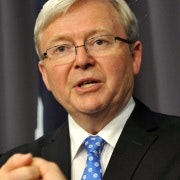Rudd's opportunity to chase 25% by 2020
Prime Minister Kevin Rudd’s announcement that he plans to “scrap the carbon tax” and move to a fully-fledged emissions trading scheme a year earlier than planned should put the focus back on Australia’s yet-to-be-confirmed 2020 carbon pollution target.
While the carbon price may rise and fall, ultimately what matters for the environment is how much pollution is saved. How much is saved by the ETS will depend on the target the government chooses to adopt.
Encouragingly, the prime minister chose to make the ETS announcement in Townsville, right on the doorstep of the Great Barrier Reef, which is at risk from runaway climate change. The symbolism was not lost on Rudd, who took the opportunity to remind us why acting on climate change is so important:
“We want our kids and our grandkids to be able to enjoy one of Australia’s greatest natural assets. We don’t want them to be able to just read about the Great Barrier Reef in some history book...We want them to experience the Great Barrier Reef in the future.”
As a father of two young children, I couldn’t agree more and I think it’s safe to assume most Australians would share this sentiment. ‘The Reef’, as we like to call it, is a treasure etched into the national psyche. Protecting it is a goal that transcends politics.
But are our political leaders really up to the challenge of protecting the Great Barrier Reef from climate change? Are they willing to ensure Australia is delivering its fair share of the global pollution cuts needed to avoid dangerous climate change?
There was no mention of what the target will be this week. The government’s existing position is that Australia should reduce emissions by at least 5 per cent below 2000 levels and could consider strengthening this to either 15 per cent or 25 per cent, depending on the level of commitment from other nations. The Opposition says it supports the government’s target range. Scientists and the Intergovernmental Panel on Climate Change (IPCC) recommend developed countries, like Australia, should commit to reductions between 25-40 per cent of 1990 levels.
The 5-25 per cent target range – supported by both the government and the Opposition – is based on the 2008 advice of Professor Ross Garnaut. Drawing on detailed global modelling, Garnaut concluded that a 25 per cent target would represent Australia’s fair share of the global effort required to provide at least a 50:50 chance of limiting global warming to two degrees Celsius.
The minimum 5 per cent target was recommended by Garnaut in 2008 as a holding position until there was more certainty about the commitments from other countries. More recently, he has argued that things have progressed sufficiently enough at the international level for Australia to lift its minimum target. Specifically, Garnaut now argues that we should be willing to at the very least match the US goal of reducing emissions by 17 per cent below 2005 levels by 2020 (equivalent to 21 per cent below 2000 levels).
While looking at what other countries are doing is important, it shouldn’t be the only factor influencing the government’s decision-making on targets. Another important factor is the impact on the economy and this is where the advantages of an internationally linked ETS really become apparent.
A recent study by Vivid Economics, with modelling by Monash University, found that with an ETS Australia can move from a 5 per cent to a 25 per cent target with almost no additional cost to the economy. The move would shave just an extra 0.01 per cent off Australia’s economic output in 2020 and reduce our national income by just 0.06 per cent.
If we can deliver a target that is five times stronger at almost no extra cost to the economy, surely this is a no-brainer.
But there are many reasons, other than that, for Australia to bump up our pollution-reduction target. Scientists now say they’ve underestimated the pace of climate change. The threat is even more urgent. But it is still possible to turn this around.
Going into a federal election the time is right for all sides of politics to show international leadership and commit to stronger targets.
It’s the least Australia can do to help save the Reef and avoid the worst impacts of climate change. As a nation we need to do our fair share and to join other countries now showing a serious commitment to the challenge. Our children deserve nothing less.
Will McGoldrick is Climate Change Policy Manager at WWF-Australia.
















